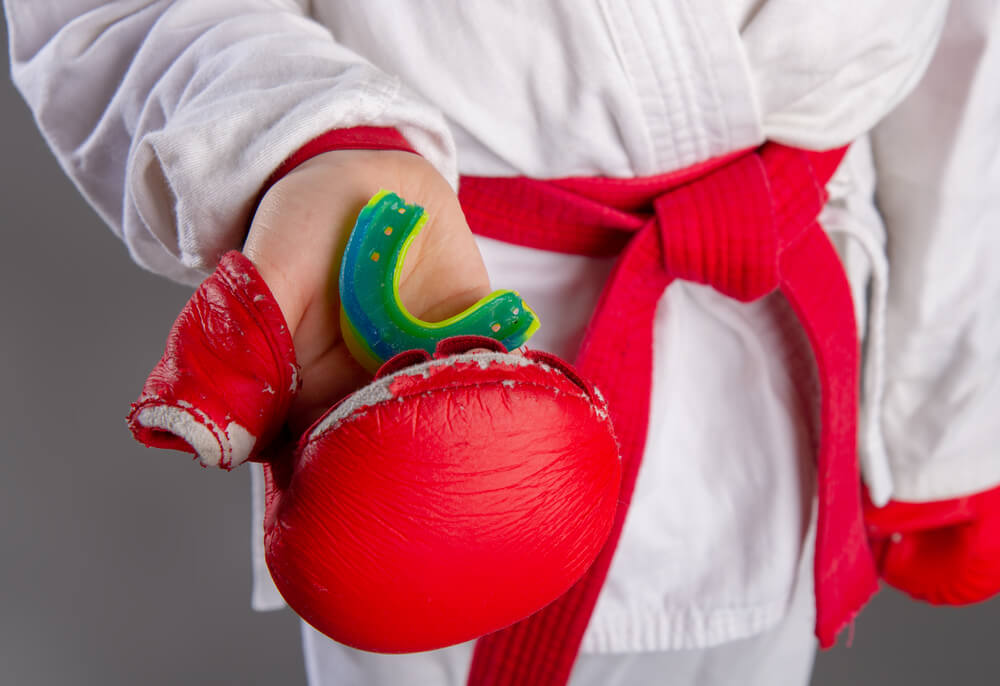If you or your children play a contact sport or participate in sports with a high risk of falling, a special guard is required to prevent damage to the mouth. The last thing you want is to leave a game without as many teeth as you started with, so making sure you have a proper mouthguard that is suited to you is very important. So what does a mouthguard do? What different kinds of mouthguards are there? How do you know which one is best for you? We’ll answer all these questions right here.
The Purpose of a Mouthguard
Mouthguards aren’t just for sports; they are meant to protect your teeth, tongue, gums, and cheeks from all sorts of possible problems. People who grind their teeth are recommended to use mouthguards to ease the stress put on the teeth and jaw, but most commonly, we see them as a piece of sports equipment. Your mouth is one of the most important parts of your body because you use it all day, every day. Protecting your teeth and mouth should be a top priority, and that’s why mouthguards are so readily available for all kinds of situations. Wearing a mouthguard can significantly reduce the risk of chipping or losing teeth, nerve damage, and damage to lips, gums, tongue, and cheeks. Mouthguards also protect braces, dental implants, and dental bridges when you have the right kind. If you regularly participate in sports or activities that risk mouth injury, a guard is imperative.
Types of Mouthguards
There are four main types of mouthguards:
- Stock
- Adjustable
- “Boil and Bite”
- Custom-Fitted
Stock
Stock mouthguards are a one-size-fits-all option that are ready to use straight off the shelf. Unfortunately, while they are the lowest cost option, they rarely fit well and provide the least protection among mouthguards. These are alright in a pinch, but if you need something to use regularly, oral health professionals would recommend that you get a mouthguard more suited to you.
Adjustable
These mouthguards are similar to the stock option but typically have sliding components that allow you to form a better fit for your mouth. Like the stock mouthguards, these can be found in most stores with a dental care section as well as online marketplaces. These and the stock option are most commonly used as night guards for grinding teeth. These are more customizable than the stock guards but still not optimal for protection during sports.
“Boil & Bite”
The instructions are in the name… kind of. These are mouthguards made of a special material that becomes extremely pliable when exposed to high temperatures. This property allows you to put the mouthguard in hot (but contrary to the name, not boiling) water for a while until the material softens. You then firmly place the mouthguard in position and bite down on it for about 20 seconds. Afterward, run it under some cool water, and it should have molded to the shape of your teeth. If it doesn’t feel right, repeat the process until you find a good fit. These mouthguards offer excellent protection because the guard is formed to your mouth and can securely provide a cushion & barrier for your whole mouth. You may find these in sporting goods stores, specialty sports stores, online, and sometimes even in the dental section of your typical shopping marts.
Custom Fitted
You can get custom-fitted mouthguards from a dental professional. Your dentist will use a mold to get an impression of your teeth and have a guard made that perfectly fits all dimensions of your teeth. These custom guards are the most pricey option, but as you can imagine, they provide the best protection out of all the types we’ve discussed. This custom guard will also be different depending on what you need it for, which makes it a great choice no matter why you might be looking for one.
So Which Mouthguard is Best for You?
It all depends on why and when you need it, but there is a pretty direct hierarchy for sporting purposes. If you have special circumstances like dental implants, consult a dental implant professional like Dr. Andrew Slavin to see what you need and have your dentist get you a custom guard. A custom-fitted guard is the best choice if you are truly looking for top-tier protection with regular use. If you are interested in maximizing protection but want to save some money and time, go for the “boil & bite” mouthguard so that you can go grab it off a shelf and have it ready to go in minutes. If you need a mouthguard immediately and have to pick one up for as cheap as possible, you can go for the adjustable guard, but this option isn’t the best for frequent use in a high-risk sport because it won’t be very well fitted to your mouth. And finally, the stock mouthguard. Honestly, to protect your mouth during a contact sport or high-risk activity, the adjustable guard is borderline, and you should not consider the stock guard. These offer a semblance of protection but are ultimately made as night guards and won’t give your mouth the safety from trauma that the others can provide.
My personal winner for the price, ease of acquiring, and level of protection provided is the Boil & Bite guard type. For the protection and customization they allow while also being able to pick one up off the shelf or find it online, Boil & Bite is the most well-rounded option out of the different types of mouthguards regarding frequent use in sports.
If you found this article too late and have already lost some chiclets, don’t worry! See if dental implants are right for you. Get a free consultation or second opinion from Dr. Andrew Slavin, DMD at Good Samaritan Dental Implant Institute. Receive unmatched patient care, expert service, and free follow-ups for life.


